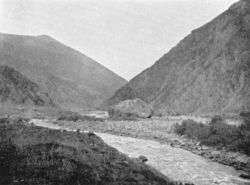Darial Gorge
The Darial Gorge (Georgian: დარიალის ხეობა, Darialis Kheoba; Russian: Дарьяльское ущелье; Ossetian: Арвыком, Arvykom; Ingush: Даьра Аьле, Dära Äle; Chechen: Теркан чӀаж, Terkan ch'azh) is a river gorge on the border between Russia and Georgia. It is at the east base of Mount Kazbek, south of present-day Vladikavkaz. The gorge was carved by the river Terek, and is approximately 13 kilometres (8.1 mi) long. The steep granite walls of the gorge can be as much as 1,800 metres (5,900 ft) tall in some places.[1]

In history
The Darial originates from Dar-i Alān (در الان) meaning "Gate of the Alans" in Persian. The Alans held the lands north of the pass in the first centuries AD. It has been fortified in ancient times by the Romans and Persians; the fortification was variously known as the Iberian Gates[lower-alpha 1] or the Caucasian Gates.[2] The pass is mentioned in the Georgian annals under the names of Darialani; Strabo calls it Porta Caucasica and Porta Cumana; Ptolemy, Fortes Sarmatica; it was sometimes known as Porta Caucasica and Portae Caspiae (a name bestowed also on the "gate" or pass beside the Caspian Sea at Derbent); and the Tatars call it Darioly.[3][1][3]
Josephus wrote that Alexander the Great built iron gates at an unspecified pass[4] which some Latin and Greek authors identified with Darial.[5]
Darial Pass fell into Sassanid hands in 252-253, when the Sassanid Empire conquered and annexed Iberia.[6] The control of the Darial Pass switched to the Western Turkic Kaganate in 628, when Tong Yabgu Kagan signed a treaty with Iberia, transferring over to the Kaganate the control of all its cities and fortresses, and establishing free trade.[7] Control of Darial Pass switched to the Arab Rashidun Caliphate in 644.[8] Afterwards, it was controlled by the Kingdom of Georgia. There was a battle point between the Ilkhanate and the Golden Horde, then indirectly controlled by Safavids and Qajar state, until it was captured by Russian Empire after annexation of Kingdom of Georgia in 1801-1830. It remained a strategic Russian forepost under Russian control until the dismemberment of the Soviet Union.
Importance
The Darial Pass was historically important as one of only two crossings of the Caucasus mountain range, the other being the Derbent Pass. As a result, Darial Gorge has been fortified since at least 150 BC.[1] Ruins of an ancient fortress are still visible. The pass served as a hub point for many roads connecting North and South Caucasus and remained open for traffic for most of its existence.
The Russian fort, Darial, which guarded this section of the Georgian Military Road, was built at the northern end of the gorge, at an altitude of 1,447 metres (4,747 ft).
The gorge has been immortalized in Russian poetry, notably by Lermontov in The Demon; it has become known as one of the most romantic places in the Caucasus.
See also
Notes
- "Garrison of the Iberians" (Greek: Iouroeipaax)
References
| Wikimedia Commons has media related to Darial Gorge. |
-

- Scheffel, Richard L.; Wernet, Susan J., eds. (1980). Natural Wonders of the World. United States of America: Reader's Digest Association, Inc. pp. 116. ISBN 0-89577-087-3.
- Van Donzel & Schmidt 2010, pp. 51–52.
- Van Donzel, Emeri; Andrea Schmidt (2010). Gog and Magog in Early Syriac and Islamic Sources: Sallam's Quest for Alexander's Wall. Brill Academic Publishers. p. 11. ISBN 978-9004174160.
- Reynolds, Gabriel Said (2007). The Qur'an in its Historical Context. Routledge. p. 186. ISBN 978-0415428996.
- Ehsan Yarshater. The Cambridge history of Iran, Volume 1. Cambridge University Press, 1983. ISBN 0-521-20092-X, 9780521200929, p. 141
- Movses Kagankatvatsi. History of Agvans (Russian trans. and ed. by Patkanov). St. Petersburg, 1861, pp. 121
- Akram A.I. The Muslim Conquest of Persia, Ch:16 ISBN 978-0-19-597713-4
- Bibliography
- Van Donzel, Emeri J.; Schmidt, Andrea Barbara (2010). Gog and Magog in Early Eastern Christian and Islamic Sources: Sallam's Quest for Alexander's Wall. Brill. ISBN 9004174168.CS1 maint: ref=harv (link)